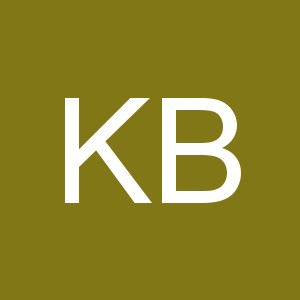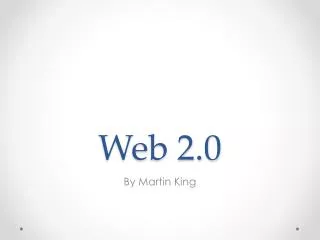
Jun 04, 2012
270 likes | 642 Views
WEB 2.0. Why is it important?. What is a web 2.0?. How can it work for teachers, librarians and information professionals?. What is Web 2.0?. The participatory web The amateurization of the web The social web The user-focused web. What is Web 2.0?. The participatory web

Share Presentation
- value content creation
- youtube com
- twitter com
- social networking
- online journal


Presentation Transcript
WEB 2.0 Why is it important? What is a web 2.0? How can it work for teachers, librarians and information professionals?
What is Web 2.0? • The participatory web • The amateurization of the web • The social web • The user-focused web
What is Web 2.0? • The Participatory Web . It marks the progression from static web pages to dynamic, interactive ones . Read/write web . Sharing, collaboration, & user involvement . Reviews . Comment on news stories . Upload photos . Share digital videos
What is Web 2.0? • The Amateurization of the Web . The average person can put their work on the web ex. Photographers, journalists, aspiring writers, students, etc.
What is Web 2.0? • The Social Web . Social networking and community- oriented sites ex. myspace.com, friendster.com, facebook.com, multiply.com, tagged.com, twitter,com, etc.
What is Web 2.0? • The User-focused Web . The user needs are catered: participate, organize, read, write & play online
Why is it important? Why use Web 2.0? • Value Content Creation . Custom search engines . Collaboration . Communication . Communication . Web-based journals/blogs . Outreach . Wikis . Instruction . Podcasts . Training . Videos and photos . Resource . Library marketing development
Why is it important? Why use Web 2.0? • Patron Interaction . Web 2.0 tools allow libraries to enter into a genuine conversation with their users. . Libraries are able to seek out and receive patron feedback and respond directly.
Why is it important? Why use Web 2.0?
Why is it important? Why use Web 2.0? • Participation in Knowledge Communities . Web 2.0 Social networks: myspace.com, multiply.com, tagged.com, facebook.com, twitter.com friendster.com, etc.
Why is it important? Why use Web 2.0? • Collaboration Assist libraries and librarians to work with distant libraries or colleagues.
Web 2.0 Best Practices • Create technical requirements • Check out what others are doing • Ask the community for help • Prototype • Consider different types of solutions
How can it Work for Librarians and Information Specialists? • With the advent of Web 2.0, we find ourselves in an age of participation – a time when all users are empowered to contribute, regardless of background or position.
Web 2.0 Tools for Librarians • Blogs – a blog, or weblog, is an online journal or web site on which articles are posted and displayed in chronological order. . Subject resources, book reviews, library news, discussion groups . Blogging software: http://wordpress.com http://www.livejournal.com http://www.blogger.com
Web 2.0 Tools for Librarians • RSS and Newsreaders . Really Simple Syndication is a technology that enables publishers to syndicate news and other contents on the web Libraries are keeping up to date by subscribing to news & information sources via RSS feeds.
Web 2.0 Tools for Librarians • WIKIS – Wiki technology provides an area for effortless collaboration and knowledge sharing among a community of users without any programming knowledge. Features: add a new page, edit page, search, comments, files and attachments, revision comparison.
Web 2.0 Tools for Librarians • Social Bookmarking . Allow users to bookmark favorite web site articles, blog posts, podcasts, images, & other web-based materials for future retrieval. ex. http://del.icio.us www.furl.net
Web 2.0 Tools for Librarians • Photosharing . Users are uploading, rating, reviewing, annotating, searching, browsing, tagging, & creating a wealth of personal, cultural & historical digital image collections. ex. www.flicker.com www.photobucket.com www.picazza.com
Web 2.0 Tools for Librarians • Social cataloging . Enable users to create personal catalogs of their book, CD, DVD, & game collections, and share them with others. ex. www.librarything.com
Web 2.0 Tools for Librarians • Video Sharing . Enable users to share, rate, comment, watch & gather around video content free of charge and technical expertise. . Amateur filmmakers, karaoke hopefuls, & even talented pets have all been given a venue to display their work. ex. youtube.com
Web 2.0 Tools for Librarians • Online Chatting – is the exchange of typed-in messages requiring one site as the repository for the messages (or "chat site") and a group of users who take part from anywhere on the Internet. . Yahoo messenger . Google talk . Skype . Meebo
Web 2.0 Tools for Librarians • Online Text Messaging – Provides text messaging from internet to cell phone/mobile phone. • Ex. Chikka.com Yahoo messenger
Reference: Cansancio, Letecia A. Web 2.0 and Library 2.0 : A Paper Presented During the Seminar- Workshop on “Dynamic Library Organization: Transforming Towards a Sustainable Future.” April 5-8, 2009, Royal Mandaya Hotel, Davao City.
- More by User

Web 2.0. Sandra Hines & Kim Estes Burleson ISD Instructional Technology. TCEA 2008 – Feb. 6, 2008 Web-20-tools.ppt. Web 2.0. Used under the Creative Commons License Adapted from presentation created by Joel Adkins http://www.slideshare.net/mrjadkins. Presenter: Joel Adkins
818 views • 45 slides

Web 2.0. By Martin King. Features of Web 2.0. Information Search: Search engine helps in finding relevant information for the keywords entered. It includes website designing, website ranking in search engine, keyword research, etc.
278 views • 9 slides

Web 2.0?. Web 1.0 Web 2.0 DoubleClick --> Google AdSense Ofoto --> Flickr Akamai --> BitTorrent mp3.com --> Napster Britannica Online --> Wikipedia personal websites --> blogging evite --> upcoming.org and EVDB domain name speculation --> search engine optimization
277 views • 13 slides

Web 2.0. Do you Web 2.0?. The following slides will show you different Web 2.0 websites and tools. To check out the websites, you can either click on the link at the bottom of the slide or click on the icon in the title. A is for. http://animoto.com/. B is for. http://blabberize.com/.
452 views • 30 slides

Web 2.0. NMTIE Dr. Linda K. Thompson Ann M. Lumm. Welcome and Introductions. Overview of Web 2.0 Tools. What is Web 2.0? go2web20 is a collection of Web 2.0 resources Video Why should educators use Web 2.0 Tools?. Collaboration and Communication Tools.
287 views • 11 slides

Web 2.0. WHAT IS WEB 2.0? How does it differ from Web 1.0?. Web 2.0 allows users to interact, share information, collaborate, and create their own contents. Web 1.0 only let users receive information but Web 2.0 allows users to comments and edit information.
209 views • 6 slides

Web 2.0. Having close relationships are critical. They can help you make decisions and be there to help you in many different ways. In order to keep valuable customers, you need to build relationships with them.
192 views • 1 slides

Web 2.0. 7-10 (12:30-3:30) 8-7 (8:30-11:30). What is Web 2.0? It is just the term for web-based applications and programs that focus on information sharing and user created content and collaboration, such as youtube, Facebook etc.
178 views • 5 slides

Web 2.0. The Read/Write Web. History. Tim Berners-Lee: World Wide Web 1989 Dream of sharing information back and forth Mosaic Web browser in 1993 Writing to the web required knowledge of HTML codes and more. The New World Wide Web. New way software developers and users utilize the web.
284 views • 16 slides

IMAGES
VIDEO
COMMENTS
Web 2.0 in PowerPoint. This document introduces Web 2.0 tools that support 21st century skills like communication, collaboration, problem solving, creativity and innovation. It lists popular Web 2.0 sites for creating, publishing, sharing and collaborating like Wikipedia, YouTube, Flickr and Facebook.
This document discusses Web 2.0 and how it differs from Web 1.0. Web 2.0 allows users to be creators of content rather than just viewers. It emphasizes openness, social networking, and microcontent. Some examples of Web 2.0 technologies include blogs, wikis, podcasts, social media sites.
Web 2.0 refers to second-generation online services that emphasize user-generated content, interoperability, and collaboration on the World Wide Web. Key aspects of Web 2.0 include AJAX (Asynchronous JavaScript and XML), which allows web pages to be updated asynchronously without reloading, RSS feeds for sharing content, and social networking ...
Web 2.0. WHAT IS WEB 2.0? How does it differ from Web 1.0?. Web 2.0 allows users to interact, share information, collaborate, and create their own contents. Web 1.0 only let users receive information but Web 2.0 allows users to comments and edit information. 209 views • 6 slides
PowerPoint Presentation - Web 2.0. Web 2.0. The Read/Write Web. History Tim Berners-Lee: World Wide Web 1989 Dream of sharing information back and forth Mosaic Web browser in 1993 Writing to the web required knowledge of HTML codes and more.
Visit www.go2web20.net In groups of three choose a web 2.0 tool to share with the class. Time to bring it all together How could these tools be used in a particular grade level and content area? What do these tools bring to a lesson that is unique?